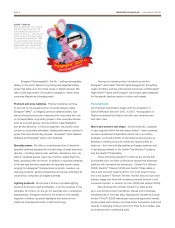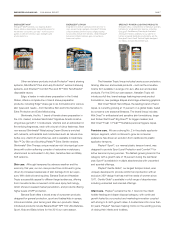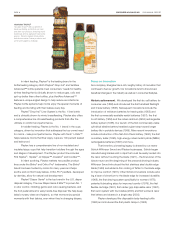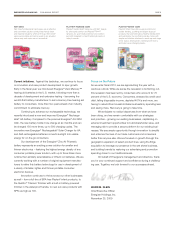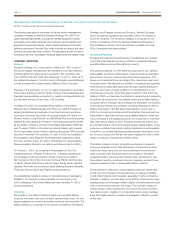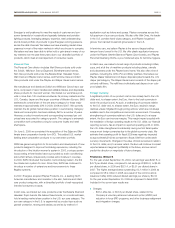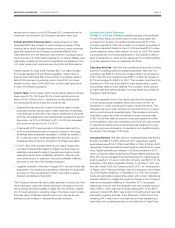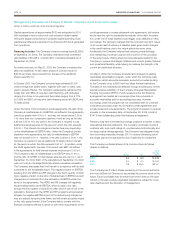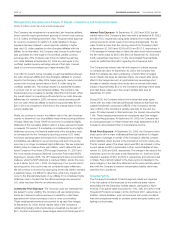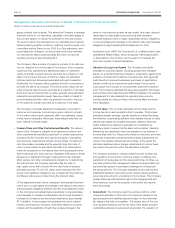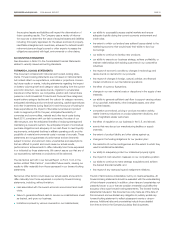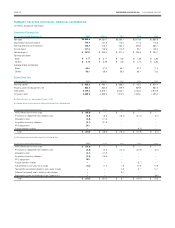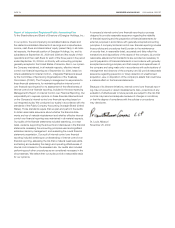Energizer 2009 Annual Report Download - page 18
Download and view the complete annual report
Please find page 18 of the 2009 Energizer annual report below. You can navigate through the pages in the report by either clicking on the pages listed below, or by using the keyword search tool below to find specific information within the annual report.
Management’s Discussion and Analysis of Results of Operations and Financial Condition
(Dollars in millions, except per share and percentage data)
PAGE 16 ENERGIZER HOLDINGS INC. 2009 ANNUAL REPORT
Capital expenditures of approximately $150 are anticipated in 2010
with increases in new product and cost reduction-related capital
driving the largest components of projected capital spending. Such
capital expenditures are expected to be financed with funds generated
from operations.
Financing Activities The Company’s total borrowings were $2,558.6
at September 30, 2009. The Company maintained total committed
debt facilities of $3,048.6, of which $477.4 remained available as of
September 30, 2009.
As noted previously, on May 20, 2009, the Company completed the
sale of an additional 10.925 million shares of common stock for
$49.00 per share. Net proceeds from the sale of the additional
shares were $510.2.
In October 2007, the Company borrowed approximately $1,500
under a bridge loan facility which, together with cash on hand, was
used to acquire Playtex. The Company subsequently refinanced the
bridge loan with $890 of long-term debt financing, with maturities
ranging from three to ten years and fixed rates ranging from 5.71%
to 6.55% and $600 of long-term bank financing priced at LIBOR plus
75 basis points.
Under the terms of the Company’s credit agreements, the ratio of the
Company’s indebtedness to its EBITDA, as defined in the agreements,
cannot be greater than 4.00 to 1, and may not remain above 3.50 to
1 for more than four consecutive quarters. If and so long as the ratio
is above 3.50 to 1 for any period, the Company is required to pay
additional interest expense for the period in which the ratio exceeds
3.50 to 1. The interest rate margin and certain fees vary depending
on the indebtedness to EBITDA ratio. Under the Company’s private
placement note agreements, the ratio of indebtedness to EBITDA
may not exceed 4.0 to 1. However, if the ratio is above 3.50 to 1, the
Company is required to pay an additional 75 basis points in interest
for the period in which the ratio exceeds 3.50 to 1. In addition, under
the credit agreements, the ratio of its current year EBIT, as defined
in the agreements, to total interest expense must exceed 3.00 to 1.
The Company’s ratio of indebtedness to its EBITDA was 3.14 to 1,
and the ratio of its EBIT to total interest expense was 4.40 to 1, as of
September 30, 2009. Each of the calculations at September 30, 2009
was pro forma for the Edge/Skintimate shave preparation acquisition.
The Company anticipates that it will remain in compliance with its debt
covenants for the foreseeable future. The negative impact on EBITDA
resulting from the VERO and RIF charges in the fourth quarter of 2009
had a negative impact on the ratio of indebtedness to EBITDA as such
charges are not excluded from the calculation of EBITDA under the
terms of the agreements. The VERO and RIF charges will negatively
impact trailing twelve month EBITDA, which is used in the ratio,
through the third quarter of fiscal 2010, after which it will roll out of the
calculation. Savings from the VERO and RIF programs will somewhat
mitigate the negative EBITDA impact of the restructuring charges as
they are realized during this time frame, and will remain a positive impact
on the ratio going forward. If the Company fails to comply with the
financial covenants referred to above or with other requirements of the
credit agreements or private placement note agreements, the lenders
would have the right to accelerate the maturity of the debt. Accelera-
tion under one of these facilities would trigger cross defaults on other
borrowings. The Company believes that the cost and long-term nature
of its current debt structure is a valuable asset given recent changes
in the credit markets due to the recent global economic crisis.
Additionally, the Company believes that reducing overall leverage
and maintaining a covenant cushion with a portion of the proceeds
of the recent equity offering should provide adequate capital for the
Company to pursue its strategic initiatives and provide greater financial
and operational flexibility, while helping to preserve the strength of its
current favorable debt structure.
On May 5, 2009, the Company amended and renewed its existing
receivables securitization program, under which the Company sells
interests in certain accounts receivable, and which provides funding
to the Company of up to $200 with two large financial institutions.
The sales of the receivables are affected through a bankruptcy remote
special purpose subsidiary of the Company, Energizer Receivables
Funding Corporation (ERFC). Funds received under this financing
arrangement are treated as borrowings rather than proceeds of
accounts receivables sold for accounting purposes. However,
borrowings under the program are not considered debt for covenant
compliance purposes under the Company’s credit agreements and
private placement note agreements. The program is subject to renewal
annually on the anniversary date. At September 30, 2009, a total of
$147.5 was outstanding under this financing arrangement.
Parties to long-term committed borrowings consist of a number of major
international financial institutions. The Company continually monitors
positions with, and credit ratings of, counterparties both internally and
by using outside ratings agencies. The Company has staggered long-
term borrowing maturities through 2017 to reduce refinancing risk in
any single year and to optimize the use of cash flow for repayment.
The Company purchased shares of its common stock as follows
(shares in millions):
Fiscal Year
Shares
Cost
Total
Average
Price
2009 0.0 $ 0.0 $ 0.00
2008 0.0 $ 0.0 $ 0.00
2007 0.8 $ 53.0 $67.67
The Company has 8 million shares remaining on the current authoriza-
tion from its Board of Directors to repurchase its common stock in the
future. Future purchases may be made from time to time on the open
market or through privately negotiated transactions, subject to corpo-
rate objectives and the discretion of management.


